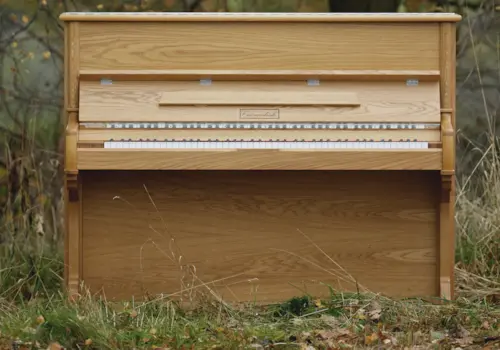Welcome to the Piano for Complete Beginners guide!
If you know little or nothing about the piano but want to learn, then you have come to the right place. In part 1 of this guide, you will:
- Learn your way around the keyboard
- Learn about finger numbering
- Learn about correct hand positioning
- Learn how to play the C major scale
Once you have completed part 1, head over to part 2 here.
But first, here's a refresher on the basics such as what piano notes and chords are.
Let's get started.
1. Learn your way around the keyboard
First things first, we need to get you familiar with the piano. If you are lucky enough to own a piano, go ahead and sit down by it. If not, save the below image and print off to use as a guide.

To somebody who has not yet begun learning - like yourself - all of these black and white notes will be very confusing! For your benefit, we have added all of the note’s names to the piano image above. If you'd like to purchase some note stickers to place on your piano, we'd recommend the below.
Another great resource we'd recommend for beginner pianists like yourself is the SimplyPiano app, which aims to help you along your learning journey with fun and easy courses, tutorials, and songs.
Your piano is made up of notes. A note is a symbol representing the pitch of sound that comes out of the instrument you are playing.
On your piano, you will see a pattern of TWO black notes, followed by THREE black notes – over and over – with white notes in between. In this lesson, we are only going to focus on the WHITE notes. You’ll notice that the notes are in alphabetical order from A to G, which repeat up the piano in cycles. What’s confusing is that the note C is officially the beginning of the cycle. Confusing, I know! Each cycle consists of EIGHT notes – C, D, E, F, G, A, B and C again.
For this lesson, we are just going to focus on 1 cycle of eight notes. See below.

Here are some tips on how to start memorising the placement of the notes:
- To the LEFT of the two black notes is C
- To the RIGHT of the two black notes is E
- To the LEFT of the three black notes is F
- To the RIGHT of the three black notes is B
The three notes we are yet to cover are D, G, and A.
You will see above that these fall in between the black notes. Have a go at the exercise below. This will help strengthen your knowledge of where the notes are on the keyboard.

2. Finger numbering
Next, we have finger numbering. Deciding which notes to play with which fingers will become very important once you can start playing pieces. So, let’s get a head start on numbering our fingers. Take a look at the diagram below to get yourself familiar.

©GetDrawings
Simple, right? Now try this exercise.

B with finger 3
F with finger 1
A with finger 1
C with finger 4
G with finger 2
E with finger 5
E with finger 5
B with finger 3
D with finger 4
C with finger 2
Now, try it in your left hand.
3. Hand positioning
This tip is crucial! You can seriously damage your hand, wrist and forearm if you adopt the wrong position. Below, you'll see the right way to position your hand vs. the wrong way to position your hand.


Your hand should rest on the keys in a semi-circle shape.
Keep your hand level with the floor. Don’t dip the wrist down.
Keep your wrist very loose.

4. The C major scale - part 1
It’s time to start playing!
First of all, what is a scale in music?
A scale is a set of musical notes ordered by fundamental frequency and pitch.
C major is the most basic and commonly used scale. There are EIGHT notes within a C major scale: C, D, E, F, G, A, B, and C. We are just going to learn the scale using your right hand.

© Quora
Task 1: Find C on the keyboard. Remember how to find it? It’s to the LEFT of the two black notes.
Task 2: Using your right hand, place finger 1 on C, finger 2 on D, and finger 3 on E.
Task 3: Spend some time playing each note separately, up and down, up and down. As you gain more confidence, start to speed up.
You have now mastered the first THREE notes of the 8-note C major scale!
Now we need to master the remaining five notes.
5. The C major scale - part 2
So far, you have played C, D and E in the C major scale. The next notes to add to this are F, G, A, B and C.
We finished the first half on note E with finger 3. F, which is the white note to the left of the three black keys, is the next note. The best thing to do here is to play F with finger 1 – your thumb.
How do we do that?
Task 1: Simply tuck your thumb underneath your three fingers to F, like below.

©PageBD
Task 2: Then, play G with finger 2, A with finger 3, B with finger 4, and finally C with finger 5.
Task 3: Spend some time playing each note separately, up and down, up and down. As you gain more confidence, start to speed up.
Task 4: Put both halves of the scale together, practising until you have nailed it.
If you’ve made it this far, congratulations! You have learnt the basics of piano playing. This is often the hardest part of the learning process. Revisit these exercises every now and then in order to keep what you have learnt fresh in your mind.
Keep an eye out for Part 2, which will be released very shortly...
Why not keep learning? Download Part 2 of Piano for Complete Beginners here.








